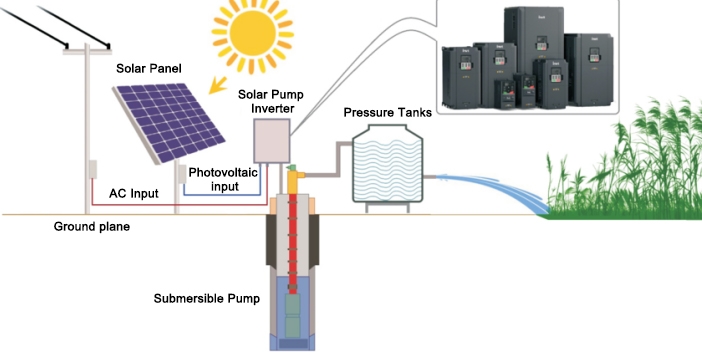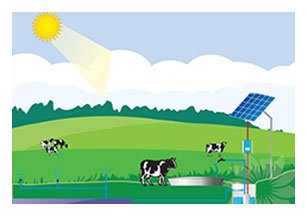Solar pump inverters are a key solar technology. Solar pump inverters allow solar energy to drive water pumping systems used in a wide range of applications such as agriculture, drinking water supply, greenhouse management, and wastewater treatment. Inverter online shop will introduce you to the working principle of solar pump inverters, the range of applications, and their advantages in sustainable energy systems.
A solar pump inverter is a device that converts the direct current (DC) electrical energy generated by solar photovoltaic panels into alternating current (AC) electrical energy so that it can be used to drive a solar water-pumping system. These systems typically include solar panels, a maximum power point tracking (MPPT) controller, an inverter, and a water pump.
Key Components
- Solar Panels: Solar panels are used to capture solar radiation and convert it into electricity. These panels usually consist of multiple solar cells that convert photons into electrons to produce DC electricity.
- MPPT Controller: The MPPT controller is used to ensure that the electricity supplied by the solar panels reaches the maximum power point. It monitors the voltage and current and automatically adjusts the voltage to maximize the energy output.
- Inverter: The inverter is the core component of the solar pump system. The solar pump inverter converts DC power into AC power for use in the pumping system.
- Solar Pump System: The solar pump system is the final device used to deliver water. AC electrical energy is supplied by the solar pump inverter to the solar water pump system to drive the excellent solar water pump.
How Does a Solar Pump Inverter Work?
Solar panels are installed in places where there is ample exposure to sunlight, such as the roof or the ground. These panels capture photons from sunlight and convert them into DC electrical energy. The voltage and current of the solar panels are monitored through an MPPT controller and the voltage is constantly adjusted to ensure that the power drawn from the panels is maximized. The solar pump inverter then converts the DC electrical energy into AC electrical energy. The converted AC power is supplied by the solar pump inverter to the solar water pump system to drive the water pump. Finally, the solar pumps transport the water from the water source to the desired location, such as agricultural fields, drinking water supply systems, greenhouses, or sewage treatment facilities.

Applications of Solar Pump Inverters
- Agricultural Irrigation: Solar pumping systems can be used to provide a source of water to improve irrigation of farmland, which helps to increase crop yields.
- Drinking Water Supply: Solar pump inverters can be used to provide clean drinking water in remote areas and regions where reliable electricity supply is lacking.
- Greenhouse Management: Temperature and humidity control in greenhouses is critical for agricultural production. Solar pump inverters can be used for water circulation and temperature control in greenhouses to improve crop-growing conditions.
- Wastewater Treatment: Solar pump inverters can be used to power wastewater treatment plants, helping to purify wastewater and reduce environmental pollution.
- Pool Circulation: Solar pump inverters can be used to circulate water in swimming pools, reducing energy consumption and improving energy efficiency.
- Desalination: Solar pump systems can be used to drive desalination equipment, converting seawater into fresh water to cope with the shortage of freshwater resources.
Advantages of Solar Pump Inverter
- Environmentally Friendly: Solar pump inverters do not produce harmful emissions, reducing the negative impact on the environment and helping to reduce the carbon footprint.

- Energy Efficiency: Using a high quality solar pump inverter can significantly reduce power consumption and lower energy costs.
- Renewable Energy: Solar energy is a renewable source of energy, and solar pump systems have a constant supply of energy that will not run out.
- Adaptable: Solar pump inverters can be used in remote areas and places where grid power is not available, providing a reliable source of energy in these areas.
- Low Maintenance: Solar pump systems typically have low maintenance costs because solar pump inverters do not have complex mechanical components.
- Remote Monitoring and Control: Some solar pump inverters are equipped with remote monitoring and control systems that allow for remote monitoring and control, reducing the need for manual intervention and increasing the reliability of the solar pump system.
- Reduced Reliance on Traditional Energy Sources: Solar pump inverters help reduce reliance on traditional energy sources, lowering the demand for oil, gas, and electricity.
As technology continues to evolve and prices fall, the application of solar pump inverters will become even more promising. Solar pump inverters will continue to provide clean, sustainable, and affordable energy solutions for a variety of applications, helping to reduce energy costs, minimize environmental impact, and advance the goals of sustainable development. In the future, solar pump inverters will continue to provide a reliable source of energy for a wide range of industries and promote the popularization and application of clean energy.
